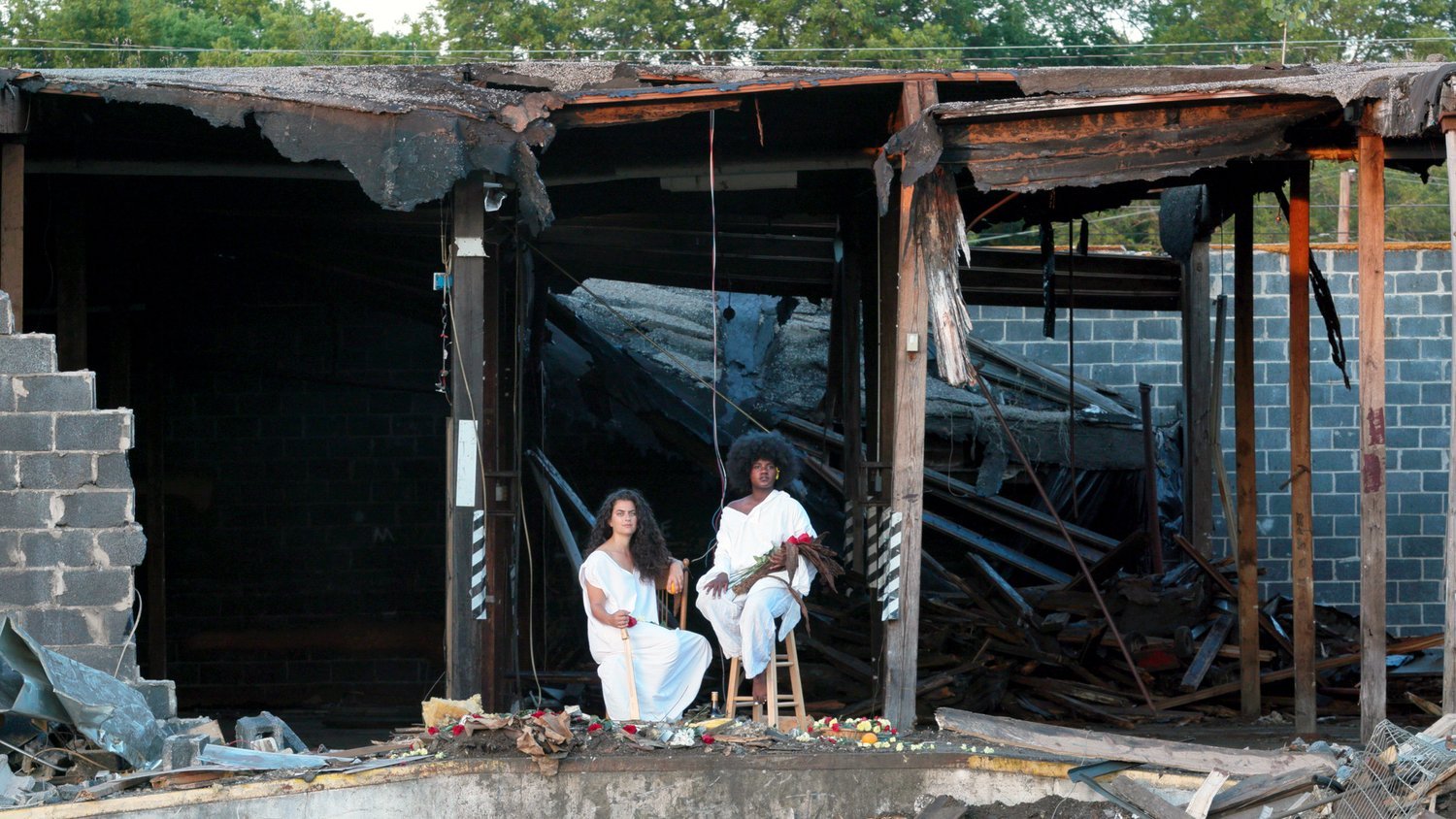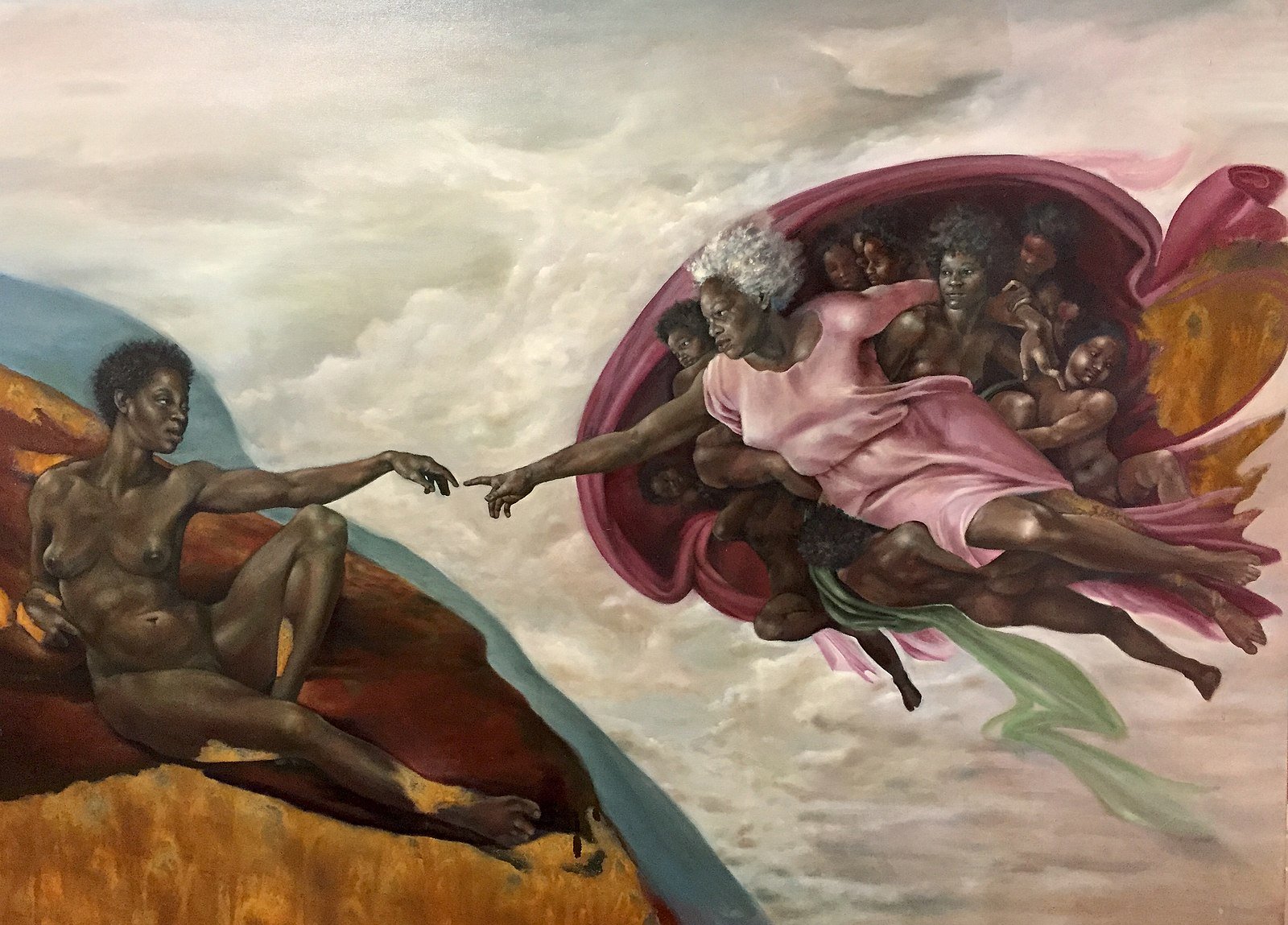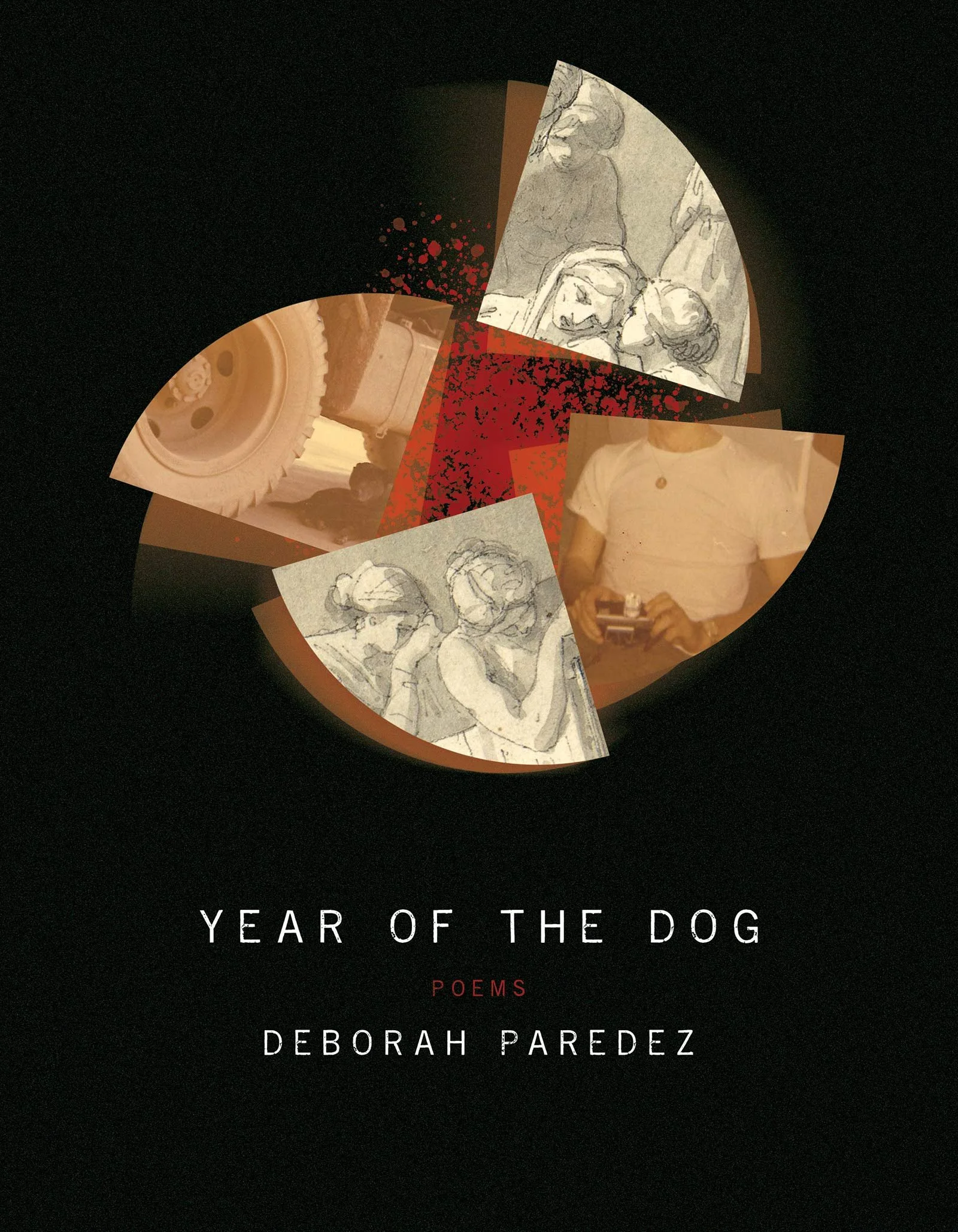Intervenxions
Selections from the online publication of The Latinx Project at NYU
Production still from Entre Puerto Rico y Richmond: Women in Resistance Shall not be Moved (2020) by Alicia Díaz, co- created with Patricia Herrera, Christine Wyatt (left), Christina Leoni-Osion (right), Luis Vasquez La Roche, Héctor “Coco” Barez, Yaraní del Valle, and David Riley. Courtesy of the Institute of Contemporary Art at Virginia Commonwealth University, Richmond.
HTI Open Plaza presents 10 selections from the archives of Intervenxions, an online publication of The Latinx Project (TLP) at New York University. Founded in 2018, TLP explores and promotes U.S. Latinx art, culture, and scholarship through creative and interdisciplinary programs. TLP is especially committed to examining and highlighting the multitude of Latinx identities as central to developing a more inclusive and equitable vision of Latinx Studies. Intervenxions features original writings, criticism, and interviews exploring contemporary Latinx art, politics, and culture.
CONVERSATIONS
The Borderlands of Latinx Indigeneity: A Conversation with Simón Trujillo and Vick Quezada
Reclaiming Our Identity: Q&A with Afro-Cuban Artist Harmonia Rosales by Jasmin Hernández
Creating a Latina Feminist Elegy in Year of the Dog: An Interview with Deborah Paredez by Yollotl López
Angelitos Negros Hablan en Samaná: Darrel Alejandro Holnes in Conversation with Patricia Encarnación
On the Magic of Photography & Its Healing Prowess: A Conversation with Rafael Soldi by Raquel Villar-Pérez
REVIEWS
Revisiting the Afro-Cuban Syncretism of “Orisha/Santos” by Néstor David Pastor
In Aida Rodriguez’s “Fighting Words,” She’s a Lover and a Fighter for Latinx Culture in Hollywood by
Jasmin Hernandez
Carlos Flores’ Ofrenda a los Arrancados: Ofrenda as Archive by Marina M. Álvarez
Claudia Martínez Garay: Sovereignty Over a Ghost Kingdom by Clara Maria Aposto
Amalia Mesa-Bains’ Venus Envy, Chapter 1: Domesticana Defiance and Ephemeral Memories by Joshua L. Gómez-Ortega
CONVERSATIONS
The Borderlands of Latinx Indigeneity
A Conversation with Simón Trujillo and Vick Quezada
By The Latinx Project | 12 March 2020
In this inaugural episode of the Intervenxions podcast, NYU professor Simón Trujillo is joined by The Latinx Project’s 2020 Artist-in-Residence Vick Quezada for an illuminating dialogue on Latinx indigeneity, representation, sexuality, and the politics of knowledge and activism. “I’m drawn really by Laguna Pueblo author Leslie Marmon Silko,” says Trujillo, “and she does a lot of work on the Pueblo deity Spider Woman, or Thought Woman…[Tsichtinako] is also cross-gender, and [not only] instructs how to grow crops but also how to make art, how to live with respect for another, how to raise children, how to take care of the sick…So there’s a kind of translator that Thought Woman performs.” READ MORE
Creation of God (oil on Belgian linen; 2017) by Harmonia Rosales: “…when you consider that all human life came out of Africa, the Garden of Eden and all, then it only makes sense to paint God as a black woman, sparking life in her own image” (Los Angeles Academy of Figurative Art).
Reclaiming Our Identity
Q&A with Afro-Cuban Artist Harmonia Rosales
By Jasmin Hernández | 2 July 2020
“Harmonia Rosales, an Afro-Cuban American contemporary painter, elevates Black womxn to extraordinary plateaus in her very grand and sweeping oil paintings. Rejecting white maleness that’s been force-fed to us over centuries by Western culture, the Chicago native rightfully centers Black womxn as the protagonists in her Renaissance-inspired canvases. In her latest exhibit, Miss Education: Reclaiming Our Identity, which opened [in March of 2020] at MOCADA, Rosales explores the United States’ puritanical values, and how it has denied the foundational position Black womxn play in society and history.”
Creating a Latina Feminist Elegy in Year of the Dog
An Interview with Deborah Paredez
By Yollotl López | 29 January 2021
“Though the Vietnam War officially ended in 1975, trauma lingers long after. Poet Deborah Paredez’s latest book Year of the Dog [BOA Editions Ltd, 2020] explores her own childhood as the daughter of a Vietnam veteran, while also tracing her father’s experience through memories, photographs, and elegiac poetry. In this collection, she creates a mosaic of history, Greek mythology, biblical allusion and Latinx folklore in order to capture the essence of fragmented memory. In doing so, she has created a new aesthetic that explores the experience of war for both soldiers and their families.”
Image still from video short produced by interdisciplinary artist Patricia Encarnación that serves as an introduction to their conversation with poet Darrel Alejandro Holnes, “Angelitos Negros Hablan en Samaná,” Intervenxions, 26 July 2022.
Angelitos Negros Hablan en Samaná
Darrel Alejandro Holnes in Conversation with Patricia Encarnación
By Latinx Project | 26 July 2022
“Samaná was once a place of refuge for Black families who sought to escape U.S. slavery and racism in the early 19th century. Situated on the northeast coast of the Dominican Republic, it is also a place of immense natural beauty, which prompted interdisciplinary artist Patricia Encarnación and award-winning poet Darrel Alejandro Holnes to meet up for a pilgrimage of sorts, spending the day in Samaná before heading back to the capital of Santo Domingo, where the two would discuss their shared diasporic identities, the influence of U.S. imperialism on their personal and familial trajectories, and the creative process behind some of their current work, among other topics. [Also featured] is a short video produced by Encarnación that serves as an introduction to their conversation.”
Patricia: “So we're in the colonial zone of the city of Santo Domingo, where colonization started on this side of the world…This cathedral [La Primada de América Cathedra-Santa María de la Encarnación] was meant to be the core foundation of the city. From there, the city expanded…That cathedral used to hold the altars of all the different Black ethnicities that lived here.”
Imagined Future #106, #122, and #139 from Imagined Futures series by Rafael Soldi; gelatin silver print from Photobooth, 2 x 1.5 inches, Unique. Courtesy of Rafael Soldi
On the Magic of Photography & Its Healing Prowess
A Conversation with Rafael Soldi
By Raquel Villar-Pérez | 20 November 2022
Rafael Soldi: “Over the course of two years, I used photo booths, resembling the Catholic confessionals of my youth, as a stage for performative rituals and a witness to a farewell. I have had a complicated relationship to Catholicism, so this became a way for me to reclaim the experience of confession. Every time an imagined future visited me, I found an empty cabin in which to close my eyes, acknowledge its presence, thank it, and give it permission to leave. Through this process I was able to say goodbye again and again, and the repetitive action of acknowledgment, gratitude, and release became very healing. It was how I addressed this monumental and yet very ambiguous grief that I and so many immigrants experience.”
REVIEWS
Revisiting the Afro-Cuban Syncretism of “Orisha/Santos”
By Néstor David Pastor | 30 October 2020
Thirty-five years ago, it would have been difficult to imagine the level of mainstream representation that Yoruba deities now enjoy in art, music, and film…[The] “Orisha/Santos: An Artistic Interpretation of the Seven African Powers”…exhibition opened in the fall of 1985 at the Museum of Contemporary Hispanic Arts (MoCHA) in the SoHo neighborhood of Lower Manhattan. Featuring a series of eight steel sculptures by Puerto Rican-born artist Jorge Luis Rodríguez, along with accompanying orisha altars by Harlem-born artist Charles Abramson, the installation was, at the time, “a pioneering exploration of the hybrid nature of Afro-Caribbean belief systems,” in the words of then-chief MoCHA curator Susana Torruella Leval.
In Aida Rodriguez’s “Fighting Words,” She’s a Lover and a Fighter for Latinx Culture in Hollywood
By Jasmin Hernández | 4 January 2022
“Fighting Words is an hour-long special [on HBO Max], broken up with a 45-minute stand-up set in the Bronx, where Rodriguez digs into her complicated family dynamics and gives a brutally honest hot take on cancel culture, and a 15-minute documentary where she travels to Puerto Rico and the Dominican Republic to soul search, awaken, and honor her roots…She candidly describes growing up in a ‘super religious’ family, including Pentecostals and Seventh-Day Adventists who were staunchly anti-abortion. “Until I got pregnant from a Black dude…then they became pro-abortion in the name of Jesus.”
Carlos Flores’ Ofrenda a los Arrancados
Ofrenda as Archive
By Marina M. Álvarez | 1 November 2022
“Carlos Flores’ Ofrenda a los Arrancados is an ofrenda dedicated to the working class communities in the Lower West Side and Southwest Side of Chicago, who have been hit hardest by the COVID-19 pandemic and its lasting effects. At first glance, the ofrenda appears raw and undone—some of the more traditional elements clash with some that appear novel or out-of-place. Yet the installation, which is featured in the 2022 Día de Muertos Memories & Offerings exhibition at the National Museum of Mexican Art in Chicago, purposefully embeds construction materials from the urban landscape, such as concrete flowers, ‘bandit signs’, and broken bottles. Flores assembles a culturally-informed alternative to the Western colonial archive, an archive to the departed in which they are reinserted into the setting from which they are being eradicated to highlight the tensions between public health, gentrification, and forced displacement.”
Claudia Martínez Garay
Sovereignty Over a Ghost Kingdom
By Clara Maria Apostolatos | 6 December 2022
“Throughout Martínez Garay's work, history becomes reconfigured into spectacular hybrid forms. Constellations of national symbols ranging from pre-Columbian artefacts to civil war imagery collapse the past and present, producing composite and nonlinear narratives of the region’s social history, indigenous vernacular, and material culture. Her most recent project and exhibition Ghost Kingdom at GRIMM gallery was a riot of color, pattern, and texture embellished with ancient and culturally resonant symbols of the Andes…Martínez Garay presents culture in its most raw forms: symbols, vernacular language, artifacts, religious and spiritual beliefs, and values that are a central part of a society, yet often intelligible and difficult to articulate plainly.”
Amalia Mesa-Bains’ Venus Envy, Chapter 1
Domesticana Defiance and Ephemeral Memories
By Joshua L. Gómez-Ortega | 20 December 2022
“What forms a memory? How do spaces provoke recollection? And how do materials hold hidden histories? Amalia Mesa-Bains explores these questions in her recent SFMOMA exhibition, Venus Envy, Chapter 1: The First Holy Communion Moments Before the End, which utilizes a variety of media to create an intimate space of contemplation that evokes childhood memories, Catholic traditions, and colonial remnants of gender. Mesa-Bains also combines material and visual culture to create a space that explores femininity, domesticity, and Chicanidad. By doing so, the installation highlights how a feminist sense of Rasquache, one that she denotes as Domesticana, composes a space for identity formation and cultural values.“
Detail from Venus Envy, Chapter 1: The First Holy Communion Moments Before the End, 1993/2022 by Amalia Mesa-Bains; mixed media. Rena Bransten Gallery, SFMOMA, San Francisco, CA. Photo: Rob Corder







